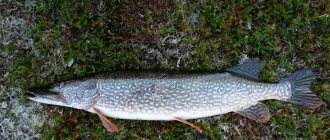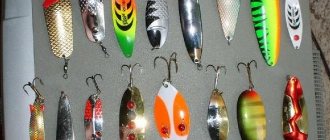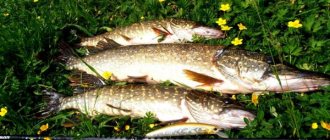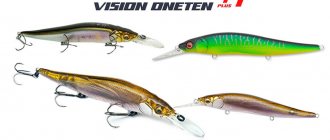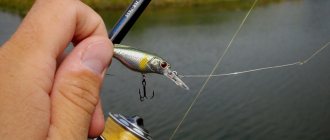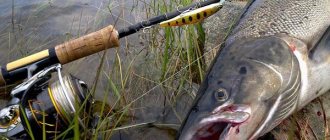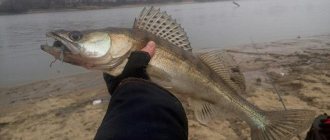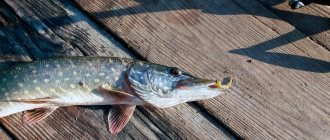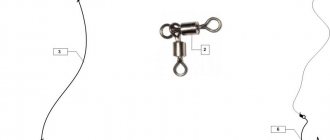Wobblers appeared in the boxes of spinners quite a long time ago and almost immediately gained popularity. However, with each new season, something new was discovered in these baits, allowing for greatly improved performance. And yet, the greatest sensation in the fishing community was made by jerk wiring. The essence of twitching wiring is alternating jerks and pauses. But for each specific wobbler and conditions, it is necessary to select the duration of stops, the strength and frequency of jerks. And don’t forget that different wobblers require different “starts”. This means that for some it’s a smooth pull throughout, for others it’s sharp, for others it’s a fairly sharp start and a smooth continuation of the jerk, or vice versa. Such nuances are determined on the water, and here it is important to have visual contact with the bait in order to learn how to control it and understand all its capabilities and features. Or at least some of them. That is, the usual “bathtub” will not give anything here - only big water. A classic wobbler for twitching is a bait of elongated geometry, the so-called “pencil” type. Such wobblers cannot boast of a pronounced game of their own and are unlikely to catch if pulled evenly.
Megabass Vision 95
This is perhaps the most famous wobbler for jerk animation. The main requirement for him is pauses. After a jerk, the wobbler does not stop immediately, but makes several oscillations in the vertical plane and after that it freezes. That is, it is important to give this pause and then make another breakthrough. The intensity of the jerks may vary, but for this wobbler, smooth pulls with a slow start are best suited. This wobbler also has a budget analogue - Kosadaka Mystic 95. However, the copy is floating and is not entirely suitable for long pauses.
Rapala X-Rap 100
This company mainly specialized in wooden lures, but with the advent of the “X” series in 2008, it received a second wind. This model was the first in the updated line and immediately gained popularity. First of all, this wobbler is very obedient, responds to any movements of the rod, flies well and, most importantly, catches fish.
However, X-Rap has a nuance: the SP mark on the packaging does not always correspond to reality. It happens that the wobbler either sinks slightly or floats up slowly. However, this flaw of the manufacturers does not in any way affect its performance characteristics.
Smith Jib 90 F. (9 cm, 6.7 g)
King of shallow waters in distant areas. A wonderful wobbler with an unusual body geometry. A distinctive feature is its rapid ascent to the surface of the water, which introduces a number of features into its wiring.
It is thanks to its “active” ascent that the Smith Jib 90 F can be carried out in the shallowest areas of reservoirs. And it is the full ascent of the wobbler to the surface that often provokes the predator to attack.
This wobbler is perfect for high-speed fishing in shallow water areas.
Excellent casting range is another important advantage of the Jib. When I first used Jib, I was surprised by one of its features - active native play. It would seem, how can a wobbler with such a small blade have its own pronounced game? But no, she is. Therefore, it can be driven by stop&go wiring, but I prefer twitching.
Yo-Zuri Hardcore Jerkbait 90
Minnow from the Hardcore series is somewhat different from other wobblers with its plump “belly” and thinner tail. The blade, similar in location and size to the blades of medium-deep-water models, should not be confusing - the wobbler does not go deeper than a meter.
This wobbler assumes quite aggressive animation, but thanks to its design features it reacts well to light movements.
Megabass FX9. (9 cm., 10.5 g.)
One of the few representatives of Megabass wobblers in my collection. I purchased this wobbler in the fall. It would seem that the pike had already begun to move to deeper parts of the reservoir, but despite this, the FX 9 did an excellent job of collecting the last pike in the shallows.
One of the features is a folding blade, which, when casting under air resistance, is pressed against the body of the bait, which has a good effect on the casting distance.
In its play, the wobbler is similar to the Smith Jib 90 F, but has a lower ascent speed and a more sweeping twitching game. Another feature is the wobbler tees - they are quite powerful and have an “external sting”, so when fishing, the number of trips is minimal. It will be possible to fully open the wobbler only in the 2015 season, but there are already some positive impressions left.
Lucky John Basara 90
In terms of geometry and its own action, this wobbler falls more into the “shead” category, but it was still created specifically for jerking retrieves. Smooth jerks and an average pace of wiring are optimal for him. This wobbler loves fairly long pauses (from two seconds). The wobbler was designed specifically for pike, which is why it is the number one target. The long-distance casting system allows them to work “across areas”, quickly processing large spaces and at the same time collecting active fish.
Jackall Tiny Magallon SPSR. (8.8 cm, 7.2 g)
This wobbler doesn’t need much introduction. He has long won the hearts of many fishermen and my heart was no exception. In common people it is better known as “tinik”. In the 2014 season, the Jackall Tiny Magallon became my favorite wobbler. More pike of various sizes have been caught with it, and medium-sized perch are also often caught with tinik.
A special feature of the wiring is a long pause; it is this that provokes the most passive predator to attack. Most often, I used this wobbler in shallow water areas, near reed thickets, at medium distances, since the wobbler is an articulated wobbler, and casting range for the wobblers is not their strong point. When purchasing the Jackall Tiny Magallon, I had high hopes for this wobbler and they were justified to an even greater extent.
Twitching is not only for minnows
Indeed, at first only “non-playing” models were twitched, because such animation suggested itself and no questions arose. And playing wobblers attract fish quite well even with a steady retrieve, so there was no need to think about twitching with them. But over time, it became clear that all wobblers and not only them can be twitched. So, the first step from the classics was jerking shads. And it gave excellent results. The only thing is that jerks with them should be short and quite sharp. And then the fats came into play. True, these were mostly shallow-water versions, but still jerking thick short wobblers gave excellent results for perch.
Features of pike fishing by twitching
Pike caught by twitching
There are some peculiarities when fishing for pike using this method. It is best to do this on swampy lakes and in the headwaters of rivers, and it does not matter whether you fish in the spring in March or in late autumn. Locations for fishing should have the following parameters: a slightly overgrown shore, a weak current, in lakes in places that are well warmed up by the sun. Such places are the most likely to find this fish.
Twitching fishing for pike proceeds as follows:
- Initially, you need to throw the bait not far from the shore, near the thickets in the pond.
- You don’t need to make any movements for about 5-7 seconds, you just need to let the wobbler drop a little.
- Since pike is a rather curious fish, it will definitely become interested in the bait, and it is at this moment that you need to start moving.
This method will allow you to get a bite literally in the first seconds.
Catching this fish involves longer jerks with a wobbler, along with short temporary pauses. When the predator is active, it is necessary to use the method of long jerks at intervals of 2-3 seconds.
Separately, it is worth mentioning the fishing technique in extreme heat, then the interval between jerks should be approximately 8-9 seconds. There are several effective tips from professionals that will help any angler when fishing for pike using the twitching method:
- the success of the catch will directly depend on the skill of controlling the wobbler, so training will be relevant;
- the twitching method gives maximum efficiency in calm and quiet water;
- During strong winds, fishing this way may not give the expected result.
Jerk retrieval of large wobblers-minnows and deep-sea minou
With the first ones everything is quite simple.
The set of gear does not have certain features: a fast or ultra-fast spinning action and a reel with good laying. Only the test should be higher than for a 95-115 mm minnow. Thus, wobblers measuring 130-150 mm weigh approximately from 16 to 32 grams. It is clear that among the smaller ones there are heavyweights, but do not forget about frontal resistance: the larger the wobbler, the greater the resistance. The only exception is the jerk minnows of the marine pencil geometry series. Among them there are models up to 250 mm long, but they weigh the same as the smaller ones. However, due to their “slenderness,” they offer virtually no resistance in water. The jerking of large wobblers looks the same as the wiring of smaller wobblers. That is, the jerk length will be approximately the same in the case of the 90 mm and 130 mm models. Only for the latter you need to pull a little harder to move it, giving a large initial acceleration. At first glance, deep-water wobblers differ from shallow-water wobblers in that they have a blade and slightly greater resistance for the same size. But in practice they behave somewhat differently. Therefore, there are two nuances that should be taken into account before jerking deep-sea wobblers. 1. A twitching rod should have a soft tip. At first glance, this contradicts the “laws” of jerk wiring, but here’s the thing. If you twitch a deep wobbler with a regular hard fishing rod, it will stray from the horizon and go significantly higher than its working level. In addition, only a soft tip will help you understand all the nuances of the deep’s behavior under water during wiring. 2. After casting, it is necessary to make from three to ten revolutions of the reel at an average pace so that the wobbler reaches the specified depth and after that begin retrieving. 3. The more aggressive the jerks, the closer to the surface the deep goes. But this feature sometimes helps. For example, in the case when a splash of pike was noticed at a casting distance in a shallow area. In order not to waste time replacing the bait, we simply throw the dip there. But in this case, the jerk drive must begin immediately after splashdown, and the drive must be aggressive. In this case, the rod tip should be kept higher. Thus, a deep-sea wobbler can be carried quite safely at a meter depth. Despite the external similarity of minnow wobblers, the behavioral nuances of each of them are different. Therefore, it is worth paying more attention to the choice of jerk strength, amplitude and pause time. Thus, by constantly experimenting with a wobbler, you can understand all the features of its behavior and use them for your own purposes. And in this case, an unspoken rule applies: the closer to Japan the wobbler is made, the more detailed you need to approach its study. In practice, this means that it is not always possible to catch an expensive bait and only over time does it begin to work at full capacity. In this case, it would be a good idea to start mastering jerking with wobblers of inexpensive brands, since budget baits are easy to learn and master. And only then move on to more expensive models. Source
Types of twitching and postings
There are three basic options for twitching wiring. Let's take a closer look at them.
Monotonous
This type of fishing shows good results when catching a striped predator - perch. It can be effectively used for active fish, “boilerfish”, and when catching rare specimens.
Important! The success of twitching fishing depends on the correct technique: the more passive the behavior of the predator, the sharper and more impulsive the movements of the rod should be.
Most often, this type of twitching wiring is acceptable for “minnow” class baits, but quite decent results are obtained when using “deep” class wobblers.
To twitch correctly, you need to:
- Throw the gear into a promising place.
- Wind excess line onto the reel.
- Place the tip of the rod near the water and place the free line on its surface.
- Without using the reel, jerk the line to the side. The result should be a jerk of the bait to the side, but no pulling.
- Hold the reel handle with your other hand and reel in the excess line.
- Continuing jerking, unwind the thread. The actions must be performed alternately, the wobbler is driven by sharp jerks with the rod, maintaining an amplitude of movements of 40 cm.
When retrieving monotonously, the rule applies: the further the cast, the sharper the jerk. This point must be taken into account when using soft types of threads, as well as when equipping the tackle with large wobblers. The optimal speed for baiting is 2 jerks per second. Here the wobbler should not be allowed to show its game; it should move exclusively to the sides.
Rhythmic
A distinctive feature of this type of wiring is the execution of a series of jerks without pauses. After which a stop is made, and the series of twitching wobblers resumes again. The fisherman himself adjusts the number of movements and the duration of the pause, taking into account the activity and fishing conditions.
Chaotic
Wiring shows its effectiveness in catching toothy beasts, especially in combination with pike baits. Due to its design features, the wobbler is able to make a greater number of jerking movements and quickly attract the attention of fish.
In principle, there are no significant differences from the previous method of fishing, with the exception of one point - each new jerk is made with increasing force. At the same time, the duration of the pause also changes. This technique allows you to create chaotic behavior of the bait, the main thing is that the fishing rod has a fast action with a soft whip. This type of wiring is also called classic twitching.
